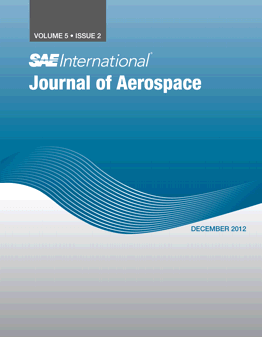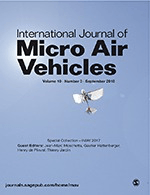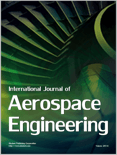
SAE International Journal of Aerospace
Scope & Guideline
Fostering the Future of Aerospace Technologies.
Introduction
Aims and Scopes
- Aerospace Vehicle Dynamics and Control:
Research on the dynamics and control systems of various aerospace vehicles, including manned, unmanned, and hypersonic vehicles, focusing on stability, control algorithms, and system optimization. - Aerospace Materials and Structures:
Studies involving the investigation of materials used in aerospace applications, including composites and their behavior under various conditions, as well as the structural integrity of aerospace components. - Aerodynamics and Fluid Mechanics:
Exploration of aerodynamic principles and fluid dynamics as they pertain to aircraft and spacecraft design, including the analysis of airflow, drag reduction, and performance enhancement. - Autonomous and Uncrewed Systems:
Focus on the development and application of autonomous systems and uncrewed aerial vehicles (UAVs), including control systems, navigation, and operational protocols. - Combustion and Propulsion Systems:
Research dedicated to the combustion processes and propulsion technologies in aerospace applications, examining efficiency, emissions, and innovative fuel types. - Data Analysis and Machine Learning Applications:
Utilization of data analysis techniques and machine learning algorithms in aerospace research, including predictive modeling, fault detection, and performance optimization.
Trending and Emerging
- Uncrewed Aerial Systems and Autonomy:
An increasing number of studies focus on the development, control, and application of uncrewed aerial systems (UAS), emphasizing autonomy, operational safety, and integration into airspace. - Machine Learning and Artificial Intelligence in Aerospace:
Emerging research themes highlight the application of machine learning and AI techniques for predictive maintenance, fault detection, and optimization of aerospace systems. - Hypersonic Vehicles and Technologies:
There is a growing interest in hypersonic flight research, including vehicle design, control systems, and aerodynamic performance, driven by advancements in materials and engineering. - Sustainability and Alternative Fuels:
Research on sustainable aerospace practices, including the use of alternative fuels and energy-efficient technologies, is becoming increasingly prominent as the industry seeks to reduce its environmental impact. - Advanced Materials and Manufacturing Techniques:
Innovations in materials science, including the use of composites and advanced manufacturing methods such as 3D printing, are gaining traction as critical areas of focus in aerospace engineering.
Declining or Waning
- Traditional Aerodynamic Testing Methods:
Research focused on classical wind tunnel testing and other traditional aerodynamic evaluation techniques has seen a reduction as more emphasis is placed on computational fluid dynamics (CFD) and simulations. - Conventional Propulsion Systems:
The exploration of traditional jet and rocket propulsion systems is declining in favor of more innovative propulsion technologies, including electric and hybrid systems. - Static Structural Analysis:
Studies that emphasize static analysis of structures without considering dynamic factors or real-world operational conditions are becoming less frequent as dynamic and real-time analysis gains importance. - General Aerospace Safety Protocols:
Studies focused on general safety protocols without a specific technological or operational innovation are being overshadowed by research that incorporates advanced technologies, predictive analytics, and machine learning.
Similar Journals

Aerospace Research in Bulgaria
Unveiling cutting-edge technologies in aerospace engineering.Aerospace Research in Bulgaria is a prestigious academic journal dedicated to advancing the field of aerospace engineering and technology. Published by the BULGARIAN ACADEMY OF SCIENCES, SPACE RESEARCH & TECHNOLOGY INSTITUTE (SRTI-BAS), this journal serves as a key platform for researchers, engineers, and professionals seeking to share original research, innovative technologies, and critical reviews related to aerospace applications. With the ISSN 1313-0927 and E-ISSN 2367-9522, the journal aims to contribute significantly to the global aerospace community. Although the journal operates under a traditional access model, it emphasizes the importance of research collaboration and disseminating knowledge in the ever-evolving aerospace sector. The editorial team is committed to maintaining high standards in peer review, making it an essential resource for academics and practitioners alike. Located at ACAD. GEORGI BONCHEV STR., SOFIA 1113, BULGARIA, this journal not only highlights Bulgarian contributions to aerospace research but also aims to engage with a broader international audience, fostering advances that propel the industry forward.

Chinese Journal of Aeronautics
Elevating aerospace research to new heights.Chinese Journal of Aeronautics, published by Elsevier Science Inc, serves as a premier platform for cutting-edge research in the field of aerospace and mechanical engineering. With an impressive impact factor that reflects its significant contribution to the discipline, this Open Access journal has been disseminated globally since 2002, allowing unrestricted access to high-quality articles and research findings. The journal is recognized for its exceptional ranking, holding a prestigious Q1 category in both Aerospace Engineering (Rank #8/153, 95th percentile) and Mechanical Engineering (Rank #46/672, 93rd percentile) as of 2023. It publishes original research, reviews, and technical notes that enhance our understanding of aeronautics and its applications, making it an essential resource for researchers, professionals, and students alike. Located in New York, USA, the journal continues to foster innovation and collaboration in aeronautical sciences, shaping the future of aviation and space exploration.

Journal of Aerospace Information Systems
Advancing the Future of Aerospace TechnologyJournal of Aerospace Information Systems, published by the American Institute of Aeronautics and Astronautics, is a premier scholarly platform dedicated to advancing the interdisciplinary field of aerospace information systems. With a focus on innovative research and practical applications, this journal supports the dynamic integration of aerospace engineering, computer science, and electrical engineering. Positioned in Q2 quartiles for 2023 in its respective categories, it ranks notably in Aerospace Engineering (#52/153) and Electrical and Electronic Engineering (#357/797), indicating its significant influence within the scientific community. Research published within its pages addresses a diverse range of technological advancements and applications that are vital for the development of contemporary aerospace systems. As an open-access journal, it facilitates broader dissemination of knowledge, allowing researchers, professionals, and students to engage with cutting-edge discoveries and methodologies. With its competitive impact and commitment to fostering innovation, the Journal of Aerospace Information Systems is an essential resource for anyone involved in the burgeoning field of aerospace technology.

International Journal of Micro Air Vehicles
Innovating the Skies: Research that Takes FlightThe International Journal of Micro Air Vehicles, published by SAGE Publications Ltd, stands as a pioneering platform for cutting-edge research in the rapidly evolving field of micro air vehicle (MAV) technology. With an ISSN of 1756-8293 and an E-ISSN of 1756-8307, this journal caters to a diverse readership, including aerospace engineers, researchers, and industry professionals who are at the forefront of innovation in aerospace engineering. It holds a commendable position within the Q3 category of Aerospace Engineering for 2023 and is ranked 65th out of 153 in Scopus, placing it in the 57th percentile among its peers. As a vital resource since its inception in 2010, the journal emphasizes advancements in design, performance, and applications of MAVs, while facilitating knowledge sharing and collaboration across disciplines. Although it operates on a subscription model, the journal ensures accessibility of pivotal research findings for professionals and scholars alike, aiming to shape the future of aerospace applications through rigorous academic inquiry.

International Journal of Turbomachinery Propulsion and Power
Exploring breakthroughs in aerospace and energy engineering.The International Journal of Turbomachinery Propulsion and Power, published by MDPI, is a pivotal scholarly platform devoted to advancing the field of turbomachinery, propulsion technology, and power systems. Since its inception in 2016, this open-access journal has provided an invaluable resource for researchers, professionals, and students within the realms of Aerospace Engineering, Energy Engineering, and Mechanical Engineering. With its current ranking in the Q3 category across these disciplines and its strategic placement in Scopus, the journal facilitates the dissemination of cutting-edge research findings and innovative solutions. The commitment to open access, effective from 2017, ensures that high-quality research is readily accessible, fostering collaboration and knowledge sharing in the global academic community. As it continues to expand its scope through 2024, the journal remains a crucial avenue for discussion, experimentation, and advancement in turbomachinery and energy-related studies.

International Journal of Aerospace Engineering
Charting the Course for Future Aerospace SolutionsThe International Journal of Aerospace Engineering, published by HINDAWI LTD, stands at the forefront of innovation and research in the field of aerospace engineering. With an impact factor reflecting its contributions to the discipline and classified in Quartile 3 (Q3) for the year 2023, this journal provides a platform for high-quality, peer-reviewed articles that delve into advancements and challenges in aerospace technology and applications. Since its inception in 2008, the journal has embraced an Open Access model, promoting unrestricted dissemination of research findings to foster collaboration and knowledge sharing among researchers, professionals, and academia. The journal covers a broad spectrum of topics, aiming to enhance understanding and give insight into aerospace engineering's multifaceted aspects. With its coverage in the Scopus database, ranking 71 out of 153 in the aerospace engineering category, the journal is a valuable resource for those engaged in this dynamic field, ensuring that high-impact research receives the visibility it deserves.

Aviation
Advancing the frontiers of aerospace engineering.Aviation, published by Vilnius Gediminas Technical University, is a leading open-access journal dedicated to the dynamic field of aerospace engineering, with an ISSN of 1648-7788 and E-ISSN of 1822-4180. Established in 2004 and set to converge in 2024, this journal aims to disseminate high-quality research that advances the understanding and application of aerospace technology. With an impact factor reflective of its contribution to the discipline, Aviation ranks at Q4 in the Aerospace Engineering category and occupies the 80th position out of 153 in Scopus, highlighting its growing significance among scholarly publications. By providing free access to its content since 2018, the journal enhances its reach and encourages collaborative efforts in the academic community, catering to researchers, professionals, and students eager to explore innovative studies and findings within aerospace engineering. Based in Lithuania, this journal serves as a vital resource for those aiming to contribute to the future of aviation.

Propulsion and Power Research
Driving Progress in Fluid Flow and Transfer Processes.Propulsion and Power Research, published by KEAI PUBLISHING LTD, is a leading Open Access journal that has been advancing the field of propulsion and power systems since its inception in 2012. With its commitment to fostering scientific discourse and innovation, the journal has gained a prominent position within academia, achieving a Q1 ranking in multiple categories such as Aerospace Engineering, Automotive Engineering, and Fluid Flow and Transfer Processes as of 2023. With an impressive ranking of #18 out of 153 in Aerospace Engineering and consistent recognition in the Scopus rankings, the journal explores critical advancements and research findings that propel the industry forward. As an Open Access publication, it ensures that groundbreaking research is readily available to a broad audience, enhancing collaboration between researchers, practitioners, and students. The journal's scope encompasses a wide range of topics within propulsion and energy solutions, making it an essential resource for anyone keen on discovering significant developments in this dynamic field.

JOURNAL OF THE ASTRONAUTICAL SCIENCES
Unveiling the Mysteries of Space ExplorationJOURNAL OF THE ASTRONAUTICAL SCIENCES, published by Springer Heidelberg, serves as a leading platform dedicated to advancing the fields of aerospace engineering and planetary science. With an ISSN of 0021-9142 and an E-ISSN of 2195-0571, this journal has established a significant presence within the academic community, evidenced by its categorization in the Q2 and Q3 quartiles for 2023, positioning it among the top publications in its field. The journal encompasses a spectrum of research that spans from innovative aerospace technologies to the exploration of planetary systems, reflecting its rich scope developed since its inception in 1969. Although not Open Access, it provides vital contributions to ongoing discussions in aerospace research, appealing to researchers, professionals, and students eager to deepen their understanding of astronautics. With a notable impact factor and rankings in Scopus—66th in Aerospace Engineering and 64th in Space and Planetary Science—this journal continues to be a pivotal resource for those engaged in the exploration and utilization of space.

Advances in Aircraft and Spacecraft Science
Unlocking New Horizons in Aerospace ResearchAdvances in Aircraft and Spacecraft Science is a distinguished journal published by TECHNO-PRESS, focusing on the rapidly evolving fields of aerospace engineering and fluid dynamics. With an ISSN of 2287-528X and an E-ISSN of 2287-5271, this journal is an invaluable resource for researchers, professionals, and students dedicated to advancing knowledge in aircraft and spacecraft technologies. Established in 2014, the journal is committed to disseminating high-quality research findings and innovative methodologies, ensuring that cutting-edge studies can be accessed globally. Despite its current position in the Q4 category for both aerospace engineering and fluid flow transfer processes, it continues to carve a niche in the academic landscape, with Scopus rankings highlighting its contribution to these fields. Operating from South Korea, Advances in Aircraft and Spacecraft Science aims to inspire collaboration and knowledge-sharing among scholars, fostering advancements that drive the aerospace industry forward.